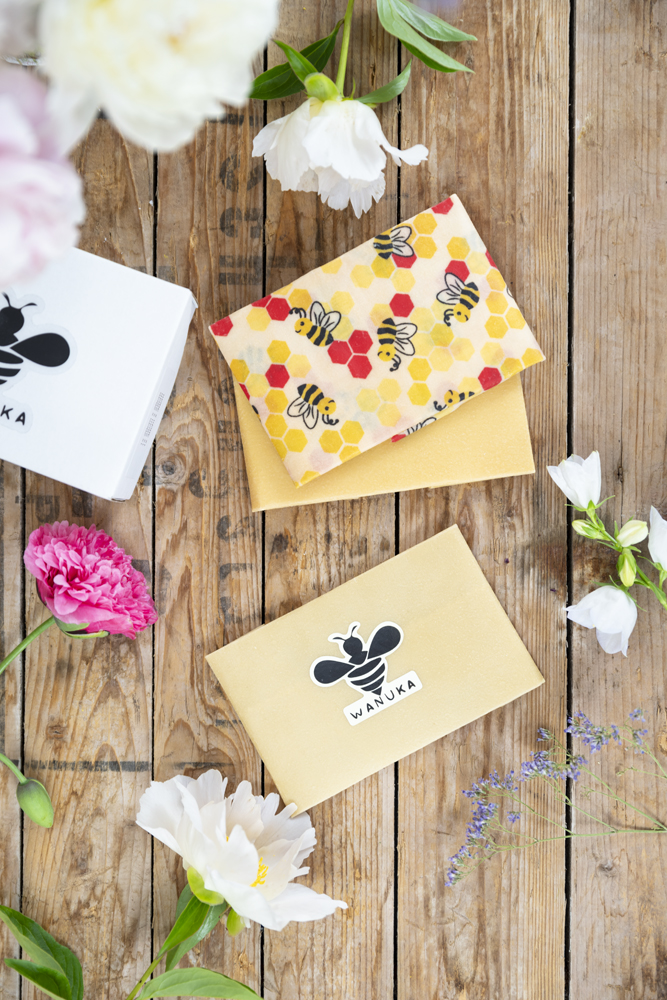
In a world that is becoming increasingly environmentally conscious, sustainable alternatives are becoming more and more important in everyday life. One notable example is beeswax wraps – an eco-friendly alternative to conventional packaging materials. Let’s dive in and find out why these beeswax wraps are so popular and versatile.
What are beeswax cloths?
Beeswax cloths are environmentally friendly alternatives to conventional packaging materials such as cling film and aluminum foil. They are made from cotton fabrics that are impregnated with a mixture of beeswax, jojoba oil and often also tree resin. These natural ingredients give the cloths their unique properties.
Properties of beeswax wipes:
- Biodegradable: Unlike plastic packaging, beeswax wraps are biodegradable and therefore help to reduce plastic waste.
- Antibacterial and antifungal: The beeswax in the wipes has natural antibacterial and antifungal properties that can help keep food fresh for longer.
- Flexible and malleable: beeswax cloths adapt to the shape of food or containers through the warmth of your hands. This means they can be used in a variety of ways.
- Beeswax cloths can be easily cleaned after use. They are reusable. Some wipes can be used for up to a year or longer.
- The production of beeswax cloths can often be sustainable. By using ecological materials and avoiding the use of harmful chemicals.
Applications of beeswax wipes:
- Food packaging: Beeswax cloths can be used to wrap food and keep it fresh. They adapt to the shape of bowls or food using the warmth of your hands.
- Covering containers: Instead of plastic wrap, beeswax cloths can be used to cover open bowls or containers.
- Wrapping food: Beeswax cloths are ideal for wrapping sandwiches or snacks.
- Storing fruit and vegetables: The cloths can also be used to keep cut fruit and vegetables fresh.
The versatility, sustainability and eco-friendliness make beeswax wraps a popular choice for people looking for more sustainable and plastic-free alternatives in everyday life.
How are beeswax wraps made?
Making beeswax wraps is a relatively simple process based on natural materials. Here is a basic guide to making beeswax wraps:
Materials for beeswax cloths
- Cotton fabric (organic cotton is often recommended)
- Beeswax (either as pellets or in block form)
- Jojoba oil
- Tree resin (optional)
- Baking paper
- Iron
- Brush
Steps for the beeswax cloths
- Prepare fabric:
- Cut the cotton fabric into the desired shape and size. This can be square or rectangular, depending on your individual needs.
- Prepare the wax:
- Melt the beeswax carefully in a double-walled pot or in a glass jar over a water bath. Add jojoba oil (in a ratio of approximately 4 parts beeswax to 1 part jojoba oil). The jojoba oil helps to keep the cloths flexible.
- Impregnation of the fabric:
- Place the prepared cotton fabric on baking paper. Using a brush, apply the melted beeswax mixture generously to the fabric. Make sure that the entire fabric is well saturated, but that there are no large puddles of wax.
- Optional addition of tree resin:
- If you wish, you can also add some tree resin to the mixture. This gives the cloths extra stickiness.
- Allow to harden:
- Allow the impregnated cotton to dry and harden. This may take a few hours.
- Remove excess wax:
- When the cloths are dry, you can remove any excess wax with an iron and baking paper. Place the baking paper over the cloth and iron it at a low temperature. The excess wax will be absorbed by the paper.
- Use and care:
- The homemade beeswax cloths are now ready for use. They can be used to wrap food, cover bowls or wrap sandwiches. To clean them, it is often sufficient to rinse them with cold water. If necessary, you can refresh the cloths again with heat.
It is important to note that the exact proportions and methods may vary depending on personal preferences and available materials. Experiment and adapt the production to your needs.
Sustainability in everyday life: How beeswax cloths can be used
The use of beeswax cloths extends across various areas of application. From food packaging to storing food in the fridge, these cloths are extremely versatile. They can be easily adapted to the shape of different foods and keep them fresh. They can also serve as an environmentally friendly alternative to cling film and aluminum foil.
Care and durability: tips for using beeswax wipes
Proper care is crucial for beeswax cloths to achieve their full lifespan. Easy handling, regular cleaning and occasional refreshing of the wax help to extend their durability. This makes them a sustainable companion in everyday life.
Make your own beeswax cloths: A DIY project for creative minds
For those who like to get creative themselves, making beeswax wraps is an easy DIY project. With just a few ingredients and a little time, you can make individual, environmentally friendly packaging solutions and give free rein to your creativity at the same time.
Conclusion: Sustainability with style – beeswax cloths in everyday use
Beeswax cloths are not only environmentally friendly, but also aesthetically pleasing. With their versatility, sustainability and individual touch, they can contribute to a more conscious lifestyle. Discover the world of beeswax wraps and set an example for a sustainable future.

